Exploring the Effects of Violent Video Games on Aggression
VerifiedAdded on 2022/11/13
|13
|3881
|145
Essay
AI Summary
This essay delves into the effects of violent video games on aggression, exploring various media effects theories such as the Knowledge Gap Theory and the Uses and Gratification Theory. It examines how media, including video games, influences individuals and society, focusing on the psychological impacts of exposure to violent content. The paper discusses research findings on the relationship between violent video game play and aggressive behavior, including both short-term and long-term effects. It also touches upon the limitations of existing research and highlights the need for further studies, particularly concerning the effects on young children and the influence of game characteristics like competition. The essay provides a comprehensive overview of the current understanding of this complex issue, drawing on a range of academic sources to present a balanced perspective on the topic.
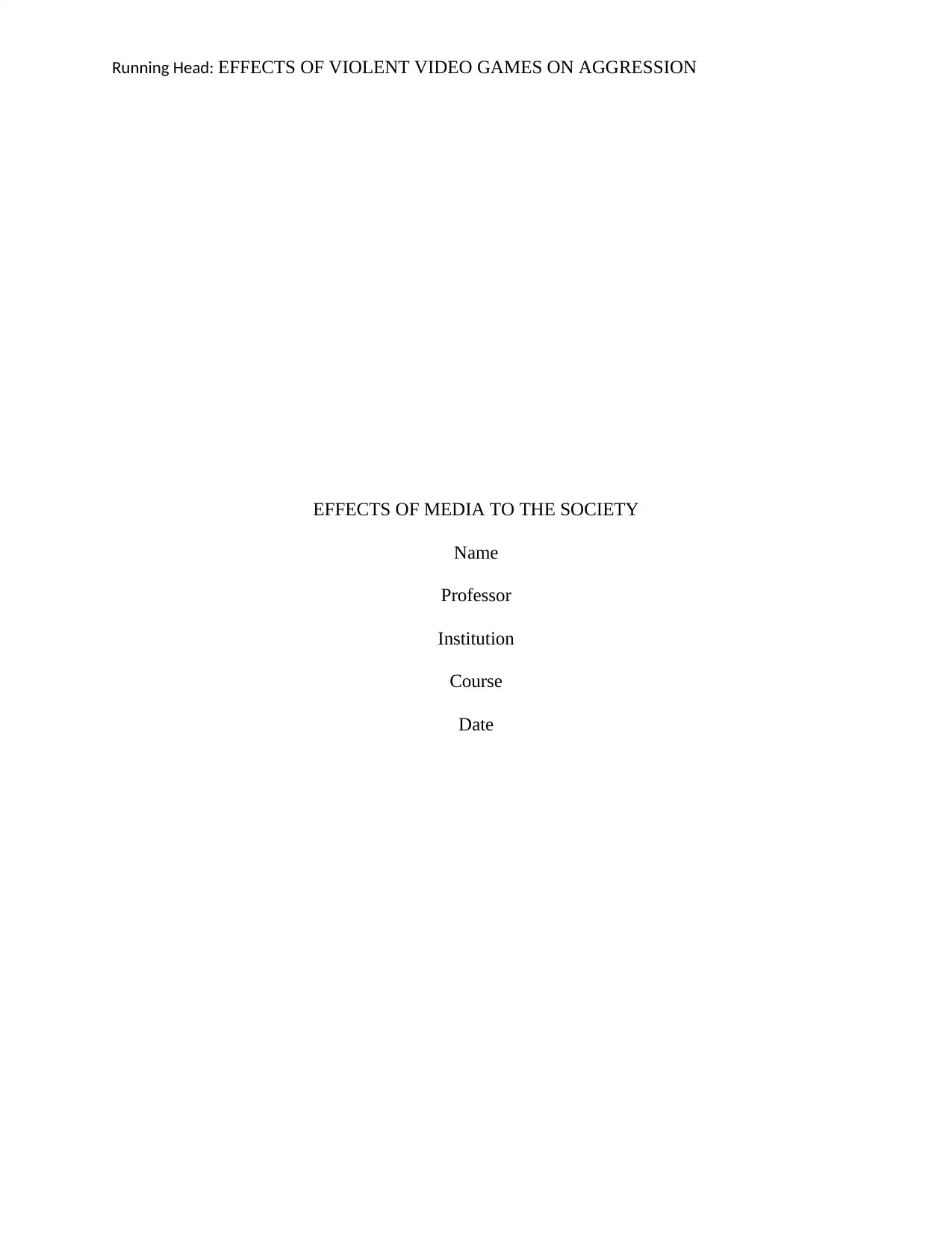
Running Head: EFFECTS OF VIOLENT VIDEO GAMES ON AGGRESSION
EFFECTS OF MEDIA TO THE SOCIETY
Name
Professor
Institution
Course
Date
EFFECTS OF MEDIA TO THE SOCIETY
Name
Professor
Institution
Course
Date
Paraphrase This Document
Need a fresh take? Get an instant paraphrase of this document with our AI Paraphraser
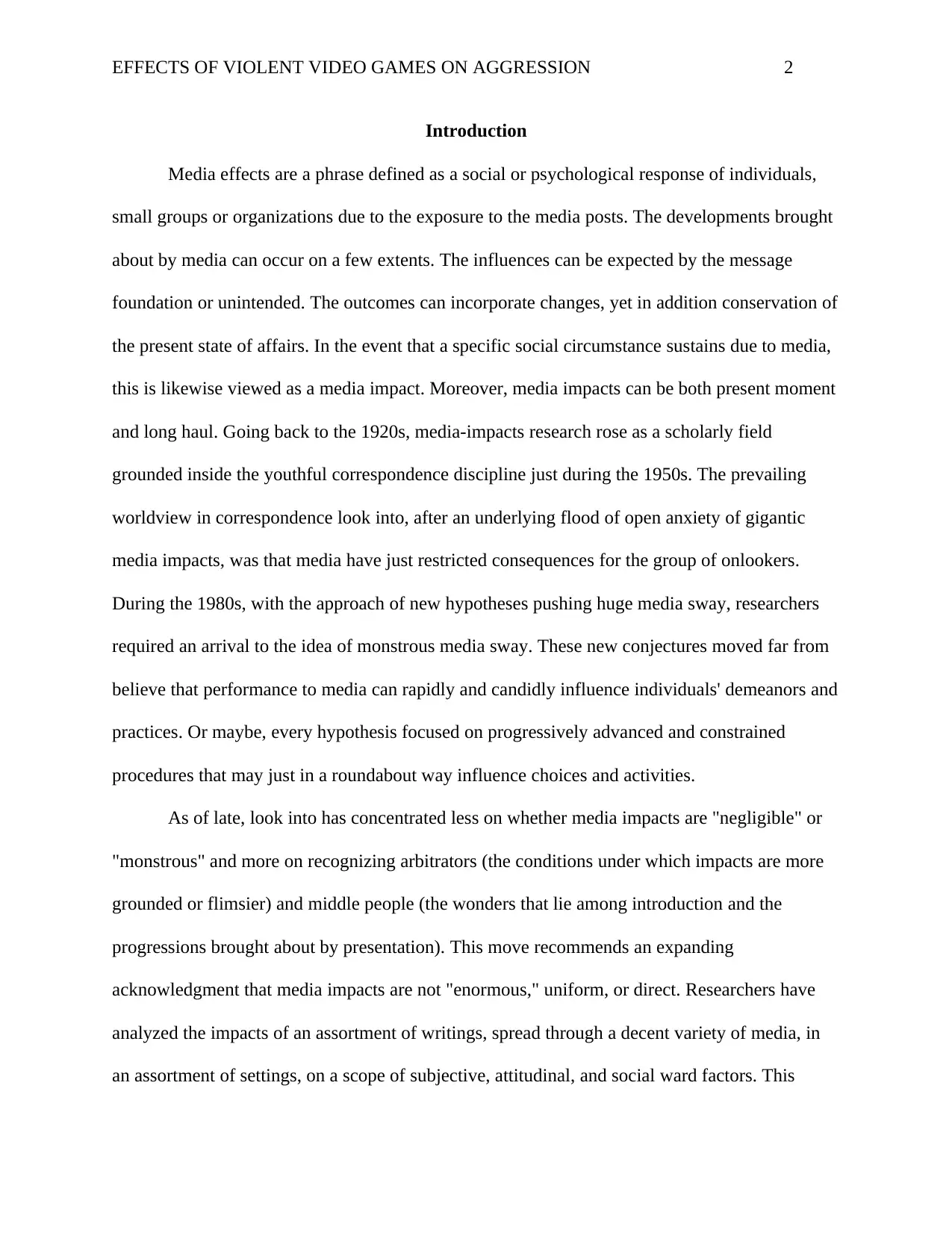
EFFECTS OF VIOLENT VIDEO GAMES ON AGGRESSION 2
Introduction
Media effects are a phrase defined as a social or psychological response of individuals,
small groups or organizations due to the exposure to the media posts. The developments brought
about by media can occur on a few extents. The influences can be expected by the message
foundation or unintended. The outcomes can incorporate changes, yet in addition conservation of
the present state of affairs. In the event that a specific social circumstance sustains due to media,
this is likewise viewed as a media impact. Moreover, media impacts can be both present moment
and long haul. Going back to the 1920s, media-impacts research rose as a scholarly field
grounded inside the youthful correspondence discipline just during the 1950s. The prevailing
worldview in correspondence look into, after an underlying flood of open anxiety of gigantic
media impacts, was that media have just restricted consequences for the group of onlookers.
During the 1980s, with the approach of new hypotheses pushing huge media sway, researchers
required an arrival to the idea of monstrous media sway. These new conjectures moved far from
believe that performance to media can rapidly and candidly influence individuals' demeanors and
practices. Or maybe, every hypothesis focused on progressively advanced and constrained
procedures that may just in a roundabout way influence choices and activities.
As of late, look into has concentrated less on whether media impacts are "negligible" or
"monstrous" and more on recognizing arbitrators (the conditions under which impacts are more
grounded or flimsier) and middle people (the wonders that lie among introduction and the
progressions brought about by presentation). This move recommends an expanding
acknowledgment that media impacts are not "enormous," uniform, or direct. Researchers have
analyzed the impacts of an assortment of writings, spread through a decent variety of media, in
an assortment of settings, on a scope of subjective, attitudinal, and social ward factors. This
Introduction
Media effects are a phrase defined as a social or psychological response of individuals,
small groups or organizations due to the exposure to the media posts. The developments brought
about by media can occur on a few extents. The influences can be expected by the message
foundation or unintended. The outcomes can incorporate changes, yet in addition conservation of
the present state of affairs. In the event that a specific social circumstance sustains due to media,
this is likewise viewed as a media impact. Moreover, media impacts can be both present moment
and long haul. Going back to the 1920s, media-impacts research rose as a scholarly field
grounded inside the youthful correspondence discipline just during the 1950s. The prevailing
worldview in correspondence look into, after an underlying flood of open anxiety of gigantic
media impacts, was that media have just restricted consequences for the group of onlookers.
During the 1980s, with the approach of new hypotheses pushing huge media sway, researchers
required an arrival to the idea of monstrous media sway. These new conjectures moved far from
believe that performance to media can rapidly and candidly influence individuals' demeanors and
practices. Or maybe, every hypothesis focused on progressively advanced and constrained
procedures that may just in a roundabout way influence choices and activities.
As of late, look into has concentrated less on whether media impacts are "negligible" or
"monstrous" and more on recognizing arbitrators (the conditions under which impacts are more
grounded or flimsier) and middle people (the wonders that lie among introduction and the
progressions brought about by presentation). This move recommends an expanding
acknowledgment that media impacts are not "enormous," uniform, or direct. Researchers have
analyzed the impacts of an assortment of writings, spread through a decent variety of media, in
an assortment of settings, on a scope of subjective, attitudinal, and social ward factors. This
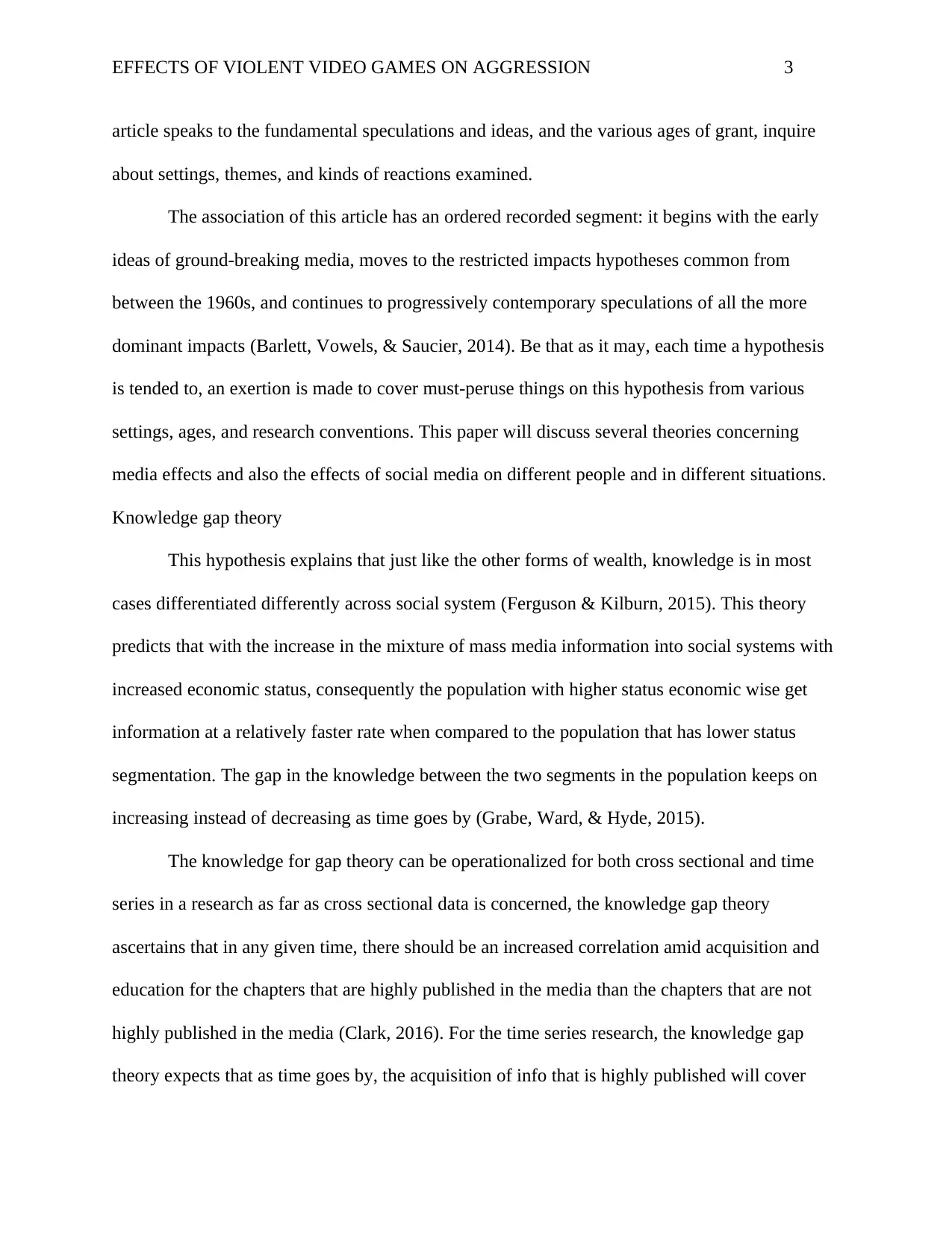
EFFECTS OF VIOLENT VIDEO GAMES ON AGGRESSION 3
article speaks to the fundamental speculations and ideas, and the various ages of grant, inquire
about settings, themes, and kinds of reactions examined.
The association of this article has an ordered recorded segment: it begins with the early
ideas of ground-breaking media, moves to the restricted impacts hypotheses common from
between the 1960s, and continues to progressively contemporary speculations of all the more
dominant impacts (Barlett, Vowels, & Saucier, 2014). Be that as it may, each time a hypothesis
is tended to, an exertion is made to cover must-peruse things on this hypothesis from various
settings, ages, and research conventions. This paper will discuss several theories concerning
media effects and also the effects of social media on different people and in different situations.
Knowledge gap theory
This hypothesis explains that just like the other forms of wealth, knowledge is in most
cases differentiated differently across social system (Ferguson & Kilburn, 2015). This theory
predicts that with the increase in the mixture of mass media information into social systems with
increased economic status, consequently the population with higher status economic wise get
information at a relatively faster rate when compared to the population that has lower status
segmentation. The gap in the knowledge between the two segments in the population keeps on
increasing instead of decreasing as time goes by (Grabe, Ward, & Hyde, 2015).
The knowledge for gap theory can be operationalized for both cross sectional and time
series in a research as far as cross sectional data is concerned, the knowledge gap theory
ascertains that in any given time, there should be an increased correlation amid acquisition and
education for the chapters that are highly published in the media than the chapters that are not
highly published in the media (Clark, 2016). For the time series research, the knowledge gap
theory expects that as time goes by, the acquisition of info that is highly published will cover
article speaks to the fundamental speculations and ideas, and the various ages of grant, inquire
about settings, themes, and kinds of reactions examined.
The association of this article has an ordered recorded segment: it begins with the early
ideas of ground-breaking media, moves to the restricted impacts hypotheses common from
between the 1960s, and continues to progressively contemporary speculations of all the more
dominant impacts (Barlett, Vowels, & Saucier, 2014). Be that as it may, each time a hypothesis
is tended to, an exertion is made to cover must-peruse things on this hypothesis from various
settings, ages, and research conventions. This paper will discuss several theories concerning
media effects and also the effects of social media on different people and in different situations.
Knowledge gap theory
This hypothesis explains that just like the other forms of wealth, knowledge is in most
cases differentiated differently across social system (Ferguson & Kilburn, 2015). This theory
predicts that with the increase in the mixture of mass media information into social systems with
increased economic status, consequently the population with higher status economic wise get
information at a relatively faster rate when compared to the population that has lower status
segmentation. The gap in the knowledge between the two segments in the population keeps on
increasing instead of decreasing as time goes by (Grabe, Ward, & Hyde, 2015).
The knowledge for gap theory can be operationalized for both cross sectional and time
series in a research as far as cross sectional data is concerned, the knowledge gap theory
ascertains that in any given time, there should be an increased correlation amid acquisition and
education for the chapters that are highly published in the media than the chapters that are not
highly published in the media (Clark, 2016). For the time series research, the knowledge gap
theory expects that as time goes by, the acquisition of info that is highly published will cover
⊘ This is a preview!⊘
Do you want full access?
Subscribe today to unlock all pages.

Trusted by 1+ million students worldwide
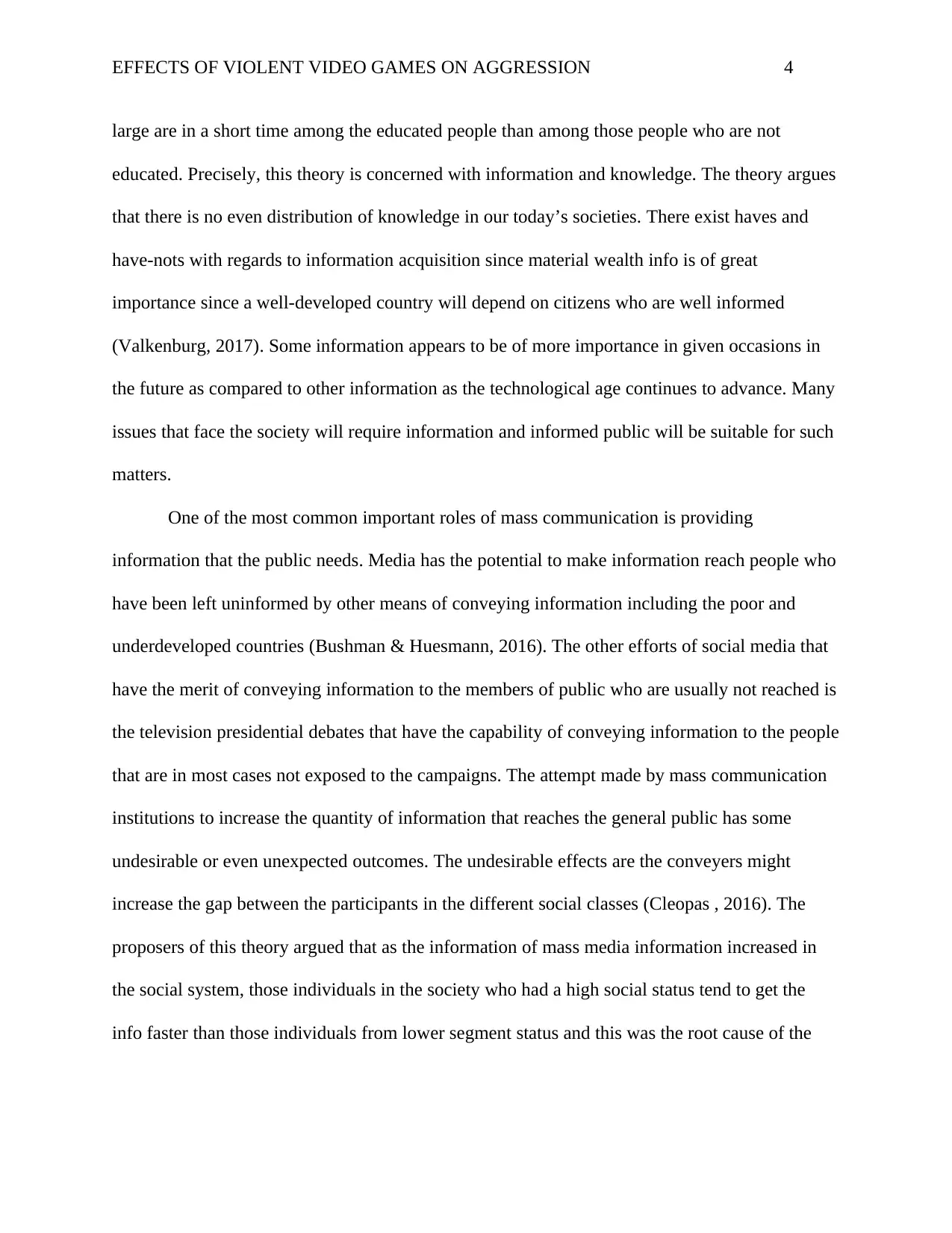
EFFECTS OF VIOLENT VIDEO GAMES ON AGGRESSION 4
large are in a short time among the educated people than among those people who are not
educated. Precisely, this theory is concerned with information and knowledge. The theory argues
that there is no even distribution of knowledge in our today’s societies. There exist haves and
have-nots with regards to information acquisition since material wealth info is of great
importance since a well-developed country will depend on citizens who are well informed
(Valkenburg, 2017). Some information appears to be of more importance in given occasions in
the future as compared to other information as the technological age continues to advance. Many
issues that face the society will require information and informed public will be suitable for such
matters.
One of the most common important roles of mass communication is providing
information that the public needs. Media has the potential to make information reach people who
have been left uninformed by other means of conveying information including the poor and
underdeveloped countries (Bushman & Huesmann, 2016). The other efforts of social media that
have the merit of conveying information to the members of public who are usually not reached is
the television presidential debates that have the capability of conveying information to the people
that are in most cases not exposed to the campaigns. The attempt made by mass communication
institutions to increase the quantity of information that reaches the general public has some
undesirable or even unexpected outcomes. The undesirable effects are the conveyers might
increase the gap between the participants in the different social classes (Cleopas , 2016). The
proposers of this theory argued that as the information of mass media information increased in
the social system, those individuals in the society who had a high social status tend to get the
info faster than those individuals from lower segment status and this was the root cause of the
large are in a short time among the educated people than among those people who are not
educated. Precisely, this theory is concerned with information and knowledge. The theory argues
that there is no even distribution of knowledge in our today’s societies. There exist haves and
have-nots with regards to information acquisition since material wealth info is of great
importance since a well-developed country will depend on citizens who are well informed
(Valkenburg, 2017). Some information appears to be of more importance in given occasions in
the future as compared to other information as the technological age continues to advance. Many
issues that face the society will require information and informed public will be suitable for such
matters.
One of the most common important roles of mass communication is providing
information that the public needs. Media has the potential to make information reach people who
have been left uninformed by other means of conveying information including the poor and
underdeveloped countries (Bushman & Huesmann, 2016). The other efforts of social media that
have the merit of conveying information to the members of public who are usually not reached is
the television presidential debates that have the capability of conveying information to the people
that are in most cases not exposed to the campaigns. The attempt made by mass communication
institutions to increase the quantity of information that reaches the general public has some
undesirable or even unexpected outcomes. The undesirable effects are the conveyers might
increase the gap between the participants in the different social classes (Cleopas , 2016). The
proposers of this theory argued that as the information of mass media information increased in
the social system, those individuals in the society who had a high social status tend to get the
info faster than those individuals from lower segment status and this was the root cause of the
Paraphrase This Document
Need a fresh take? Get an instant paraphrase of this document with our AI Paraphraser
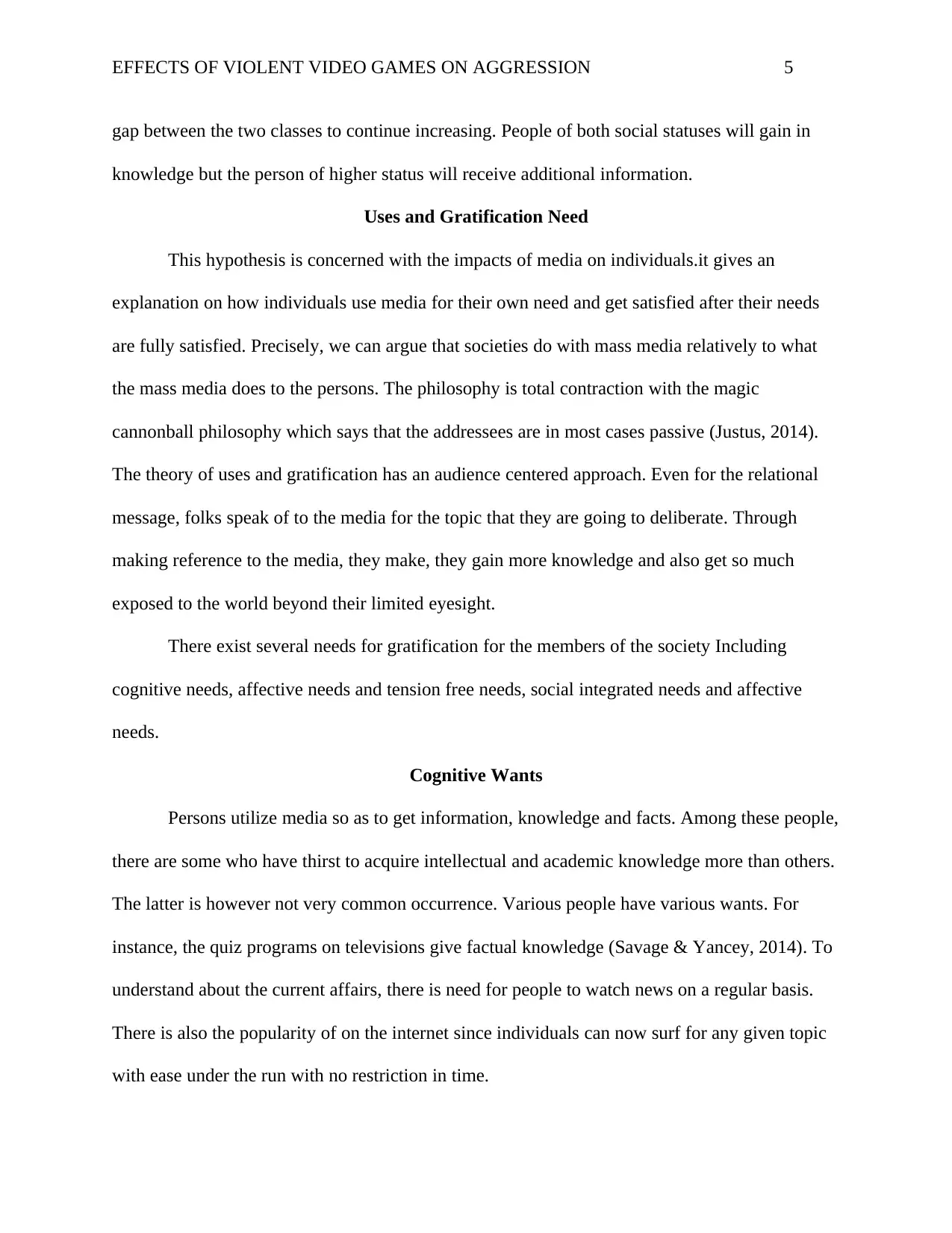
EFFECTS OF VIOLENT VIDEO GAMES ON AGGRESSION 5
gap between the two classes to continue increasing. People of both social statuses will gain in
knowledge but the person of higher status will receive additional information.
Uses and Gratification Need
This hypothesis is concerned with the impacts of media on individuals.it gives an
explanation on how individuals use media for their own need and get satisfied after their needs
are fully satisfied. Precisely, we can argue that societies do with mass media relatively to what
the mass media does to the persons. The philosophy is total contraction with the magic
cannonball philosophy which says that the addressees are in most cases passive (Justus, 2014).
The theory of uses and gratification has an audience centered approach. Even for the relational
message, folks speak of to the media for the topic that they are going to deliberate. Through
making reference to the media, they make, they gain more knowledge and also get so much
exposed to the world beyond their limited eyesight.
There exist several needs for gratification for the members of the society Including
cognitive needs, affective needs and tension free needs, social integrated needs and affective
needs.
Cognitive Wants
Persons utilize media so as to get information, knowledge and facts. Among these people,
there are some who have thirst to acquire intellectual and academic knowledge more than others.
The latter is however not very common occurrence. Various people have various wants. For
instance, the quiz programs on televisions give factual knowledge (Savage & Yancey, 2014). To
understand about the current affairs, there is need for people to watch news on a regular basis.
There is also the popularity of on the internet since individuals can now surf for any given topic
with ease under the run with no restriction in time.
gap between the two classes to continue increasing. People of both social statuses will gain in
knowledge but the person of higher status will receive additional information.
Uses and Gratification Need
This hypothesis is concerned with the impacts of media on individuals.it gives an
explanation on how individuals use media for their own need and get satisfied after their needs
are fully satisfied. Precisely, we can argue that societies do with mass media relatively to what
the mass media does to the persons. The philosophy is total contraction with the magic
cannonball philosophy which says that the addressees are in most cases passive (Justus, 2014).
The theory of uses and gratification has an audience centered approach. Even for the relational
message, folks speak of to the media for the topic that they are going to deliberate. Through
making reference to the media, they make, they gain more knowledge and also get so much
exposed to the world beyond their limited eyesight.
There exist several needs for gratification for the members of the society Including
cognitive needs, affective needs and tension free needs, social integrated needs and affective
needs.
Cognitive Wants
Persons utilize media so as to get information, knowledge and facts. Among these people,
there are some who have thirst to acquire intellectual and academic knowledge more than others.
The latter is however not very common occurrence. Various people have various wants. For
instance, the quiz programs on televisions give factual knowledge (Savage & Yancey, 2014). To
understand about the current affairs, there is need for people to watch news on a regular basis.
There is also the popularity of on the internet since individuals can now surf for any given topic
with ease under the run with no restriction in time.
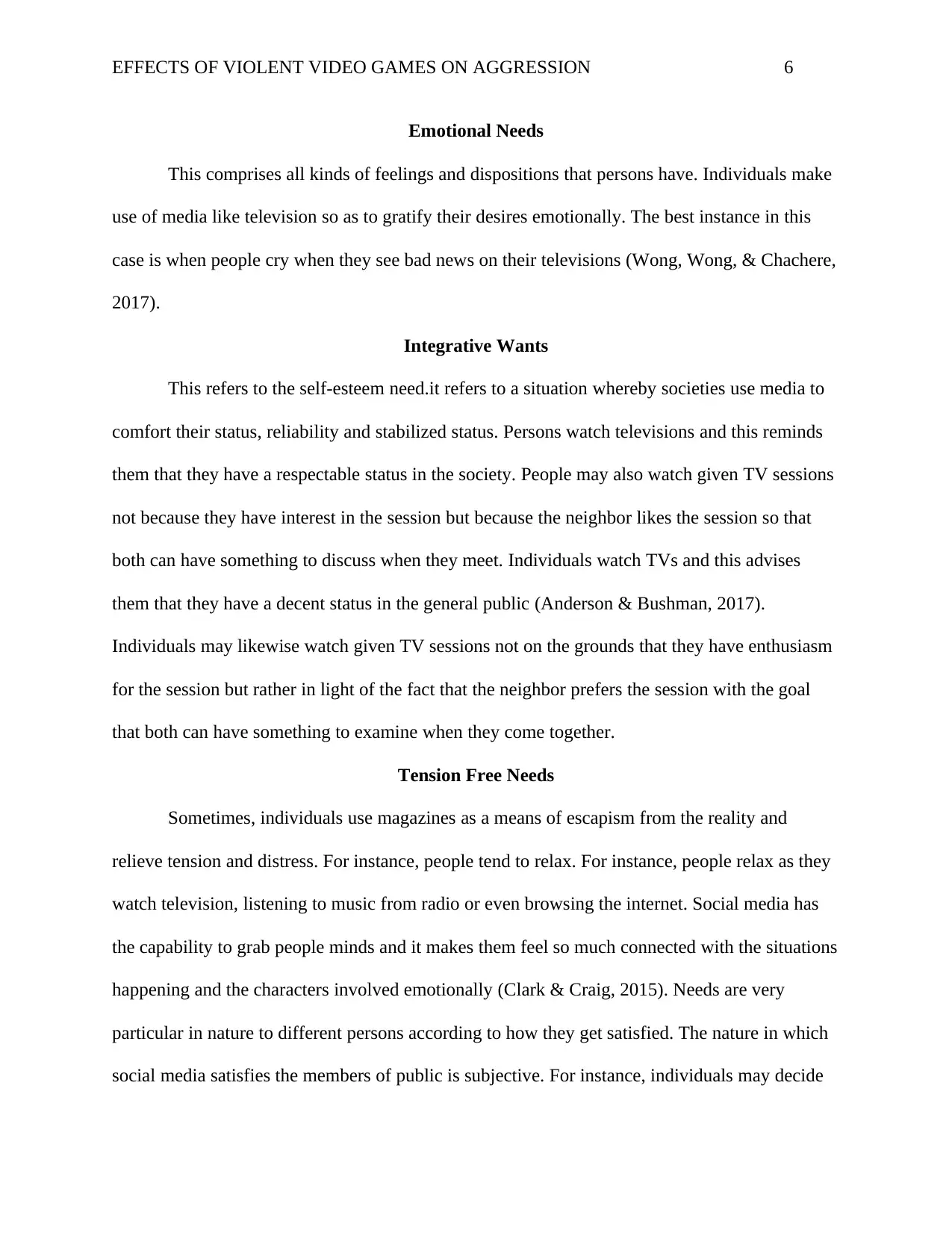
EFFECTS OF VIOLENT VIDEO GAMES ON AGGRESSION 6
Emotional Needs
This comprises all kinds of feelings and dispositions that persons have. Individuals make
use of media like television so as to gratify their desires emotionally. The best instance in this
case is when people cry when they see bad news on their televisions (Wong, Wong, & Chachere,
2017).
Integrative Wants
This refers to the self-esteem need.it refers to a situation whereby societies use media to
comfort their status, reliability and stabilized status. Persons watch televisions and this reminds
them that they have a respectable status in the society. People may also watch given TV sessions
not because they have interest in the session but because the neighbor likes the session so that
both can have something to discuss when they meet. Individuals watch TVs and this advises
them that they have a decent status in the general public (Anderson & Bushman, 2017).
Individuals may likewise watch given TV sessions not on the grounds that they have enthusiasm
for the session but rather in light of the fact that the neighbor prefers the session with the goal
that both can have something to examine when they come together.
Tension Free Needs
Sometimes, individuals use magazines as a means of escapism from the reality and
relieve tension and distress. For instance, people tend to relax. For instance, people relax as they
watch television, listening to music from radio or even browsing the internet. Social media has
the capability to grab people minds and it makes them feel so much connected with the situations
happening and the characters involved emotionally (Clark & Craig, 2015). Needs are very
particular in nature to different persons according to how they get satisfied. The nature in which
social media satisfies the members of public is subjective. For instance, individuals may decide
Emotional Needs
This comprises all kinds of feelings and dispositions that persons have. Individuals make
use of media like television so as to gratify their desires emotionally. The best instance in this
case is when people cry when they see bad news on their televisions (Wong, Wong, & Chachere,
2017).
Integrative Wants
This refers to the self-esteem need.it refers to a situation whereby societies use media to
comfort their status, reliability and stabilized status. Persons watch televisions and this reminds
them that they have a respectable status in the society. People may also watch given TV sessions
not because they have interest in the session but because the neighbor likes the session so that
both can have something to discuss when they meet. Individuals watch TVs and this advises
them that they have a decent status in the general public (Anderson & Bushman, 2017).
Individuals may likewise watch given TV sessions not on the grounds that they have enthusiasm
for the session but rather in light of the fact that the neighbor prefers the session with the goal
that both can have something to examine when they come together.
Tension Free Needs
Sometimes, individuals use magazines as a means of escapism from the reality and
relieve tension and distress. For instance, people tend to relax. For instance, people relax as they
watch television, listening to music from radio or even browsing the internet. Social media has
the capability to grab people minds and it makes them feel so much connected with the situations
happening and the characters involved emotionally (Clark & Craig, 2015). Needs are very
particular in nature to different persons according to how they get satisfied. The nature in which
social media satisfies the members of public is subjective. For instance, individuals may decide
⊘ This is a preview!⊘
Do you want full access?
Subscribe today to unlock all pages.

Trusted by 1+ million students worldwide
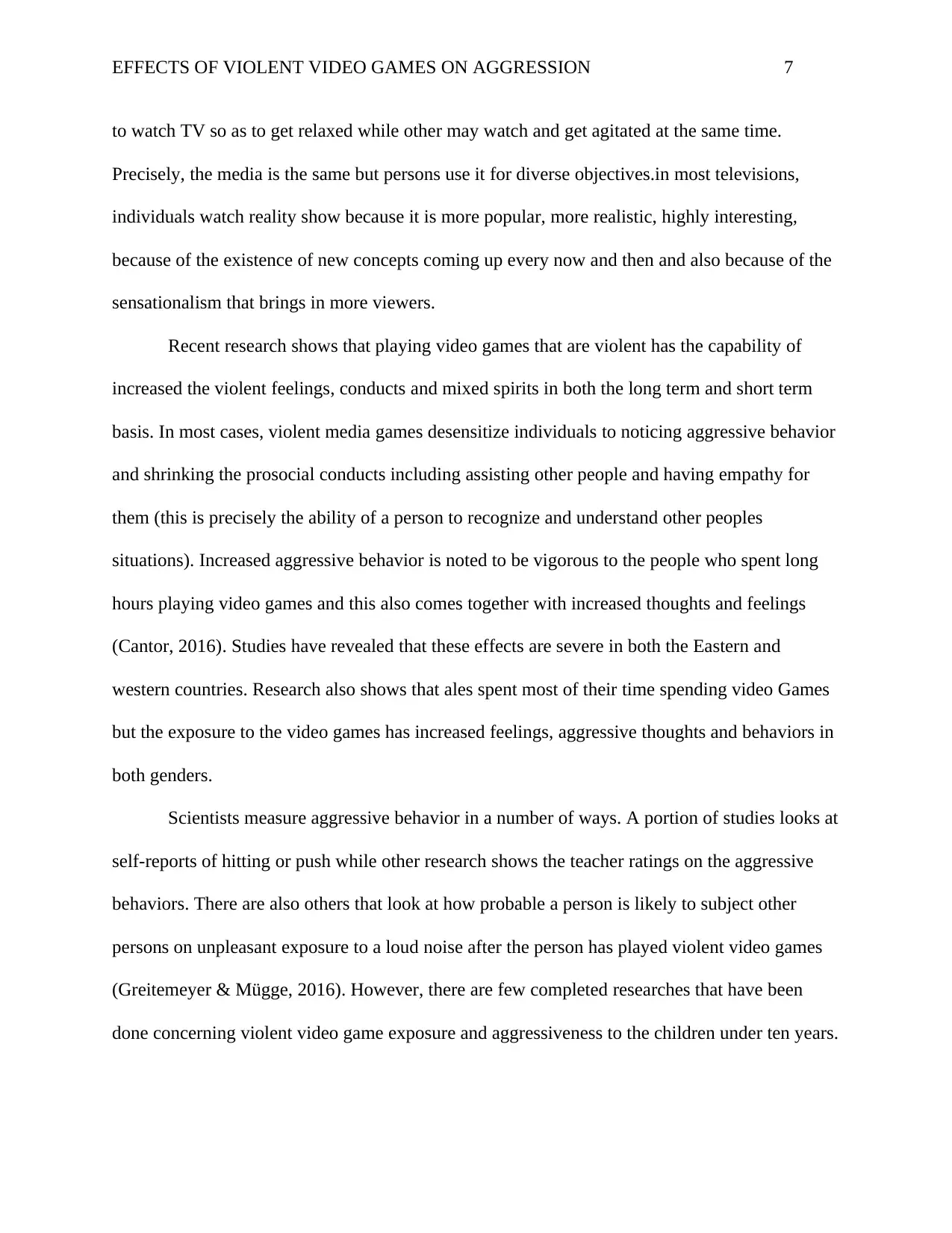
EFFECTS OF VIOLENT VIDEO GAMES ON AGGRESSION 7
to watch TV so as to get relaxed while other may watch and get agitated at the same time.
Precisely, the media is the same but persons use it for diverse objectives.in most televisions,
individuals watch reality show because it is more popular, more realistic, highly interesting,
because of the existence of new concepts coming up every now and then and also because of the
sensationalism that brings in more viewers.
Recent research shows that playing video games that are violent has the capability of
increased the violent feelings, conducts and mixed spirits in both the long term and short term
basis. In most cases, violent media games desensitize individuals to noticing aggressive behavior
and shrinking the prosocial conducts including assisting other people and having empathy for
them (this is precisely the ability of a person to recognize and understand other peoples
situations). Increased aggressive behavior is noted to be vigorous to the people who spent long
hours playing video games and this also comes together with increased thoughts and feelings
(Cantor, 2016). Studies have revealed that these effects are severe in both the Eastern and
western countries. Research also shows that ales spent most of their time spending video Games
but the exposure to the video games has increased feelings, aggressive thoughts and behaviors in
both genders.
Scientists measure aggressive behavior in a number of ways. A portion of studies looks at
self-reports of hitting or push while other research shows the teacher ratings on the aggressive
behaviors. There are also others that look at how probable a person is likely to subject other
persons on unpleasant exposure to a loud noise after the person has played violent video games
(Greitemeyer & Mügge, 2016). However, there are few completed researches that have been
done concerning violent video game exposure and aggressiveness to the children under ten years.
to watch TV so as to get relaxed while other may watch and get agitated at the same time.
Precisely, the media is the same but persons use it for diverse objectives.in most televisions,
individuals watch reality show because it is more popular, more realistic, highly interesting,
because of the existence of new concepts coming up every now and then and also because of the
sensationalism that brings in more viewers.
Recent research shows that playing video games that are violent has the capability of
increased the violent feelings, conducts and mixed spirits in both the long term and short term
basis. In most cases, violent media games desensitize individuals to noticing aggressive behavior
and shrinking the prosocial conducts including assisting other people and having empathy for
them (this is precisely the ability of a person to recognize and understand other peoples
situations). Increased aggressive behavior is noted to be vigorous to the people who spent long
hours playing video games and this also comes together with increased thoughts and feelings
(Cantor, 2016). Studies have revealed that these effects are severe in both the Eastern and
western countries. Research also shows that ales spent most of their time spending video Games
but the exposure to the video games has increased feelings, aggressive thoughts and behaviors in
both genders.
Scientists measure aggressive behavior in a number of ways. A portion of studies looks at
self-reports of hitting or push while other research shows the teacher ratings on the aggressive
behaviors. There are also others that look at how probable a person is likely to subject other
persons on unpleasant exposure to a loud noise after the person has played violent video games
(Greitemeyer & Mügge, 2016). However, there are few completed researches that have been
done concerning violent video game exposure and aggressiveness to the children under ten years.
Paraphrase This Document
Need a fresh take? Get an instant paraphrase of this document with our AI Paraphraser
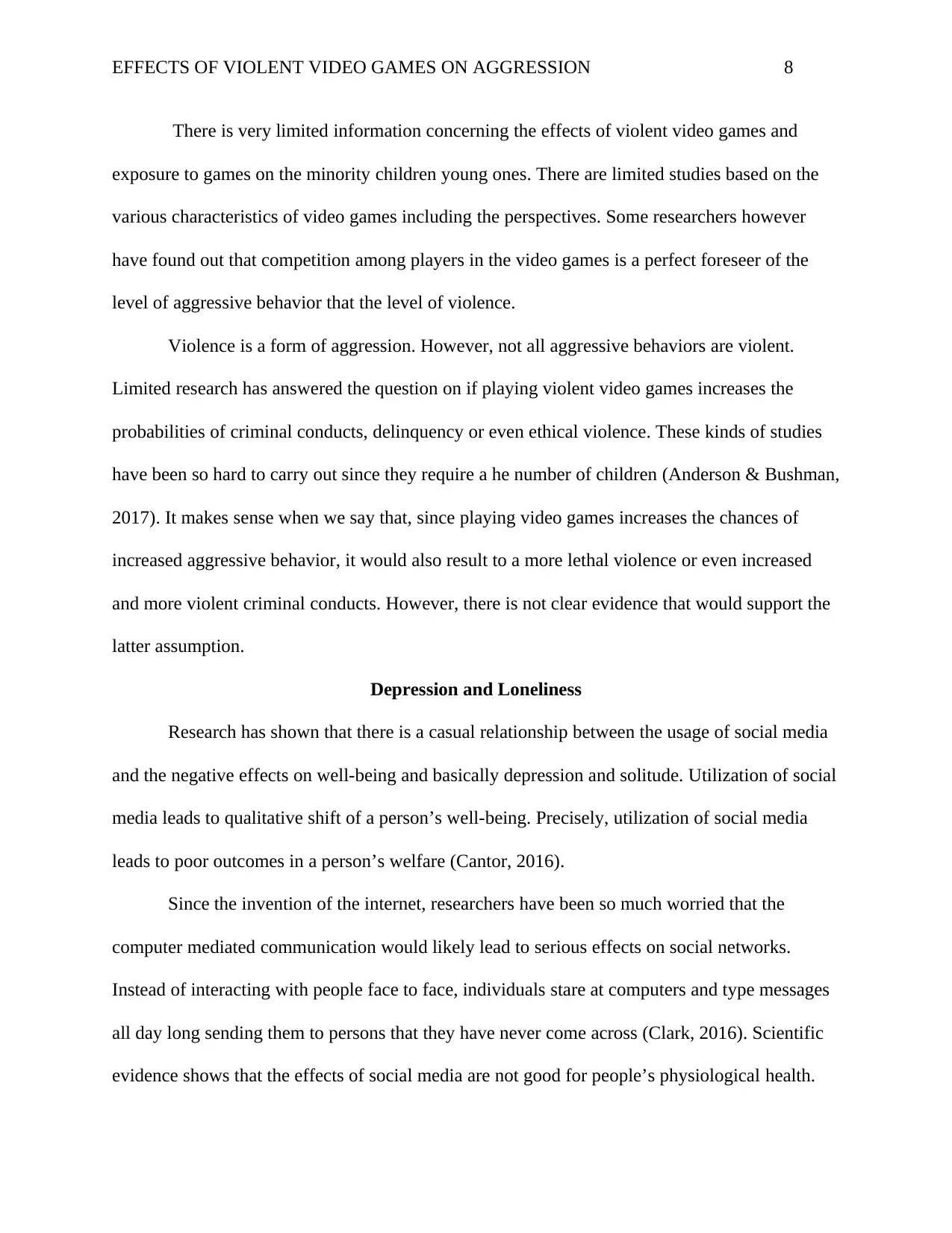
EFFECTS OF VIOLENT VIDEO GAMES ON AGGRESSION 8
There is very limited information concerning the effects of violent video games and
exposure to games on the minority children young ones. There are limited studies based on the
various characteristics of video games including the perspectives. Some researchers however
have found out that competition among players in the video games is a perfect foreseer of the
level of aggressive behavior that the level of violence.
Violence is a form of aggression. However, not all aggressive behaviors are violent.
Limited research has answered the question on if playing violent video games increases the
probabilities of criminal conducts, delinquency or even ethical violence. These kinds of studies
have been so hard to carry out since they require a he number of children (Anderson & Bushman,
2017). It makes sense when we say that, since playing video games increases the chances of
increased aggressive behavior, it would also result to a more lethal violence or even increased
and more violent criminal conducts. However, there is not clear evidence that would support the
latter assumption.
Depression and Loneliness
Research has shown that there is a casual relationship between the usage of social media
and the negative effects on well-being and basically depression and solitude. Utilization of social
media leads to qualitative shift of a person’s well-being. Precisely, utilization of social media
leads to poor outcomes in a person’s welfare (Cantor, 2016).
Since the invention of the internet, researchers have been so much worried that the
computer mediated communication would likely lead to serious effects on social networks.
Instead of interacting with people face to face, individuals stare at computers and type messages
all day long sending them to persons that they have never come across (Clark, 2016). Scientific
evidence shows that the effects of social media are not good for people’s physiological health.
There is very limited information concerning the effects of violent video games and
exposure to games on the minority children young ones. There are limited studies based on the
various characteristics of video games including the perspectives. Some researchers however
have found out that competition among players in the video games is a perfect foreseer of the
level of aggressive behavior that the level of violence.
Violence is a form of aggression. However, not all aggressive behaviors are violent.
Limited research has answered the question on if playing violent video games increases the
probabilities of criminal conducts, delinquency or even ethical violence. These kinds of studies
have been so hard to carry out since they require a he number of children (Anderson & Bushman,
2017). It makes sense when we say that, since playing video games increases the chances of
increased aggressive behavior, it would also result to a more lethal violence or even increased
and more violent criminal conducts. However, there is not clear evidence that would support the
latter assumption.
Depression and Loneliness
Research has shown that there is a casual relationship between the usage of social media
and the negative effects on well-being and basically depression and solitude. Utilization of social
media leads to qualitative shift of a person’s well-being. Precisely, utilization of social media
leads to poor outcomes in a person’s welfare (Cantor, 2016).
Since the invention of the internet, researchers have been so much worried that the
computer mediated communication would likely lead to serious effects on social networks.
Instead of interacting with people face to face, individuals stare at computers and type messages
all day long sending them to persons that they have never come across (Clark, 2016). Scientific
evidence shows that the effects of social media are not good for people’s physiological health.
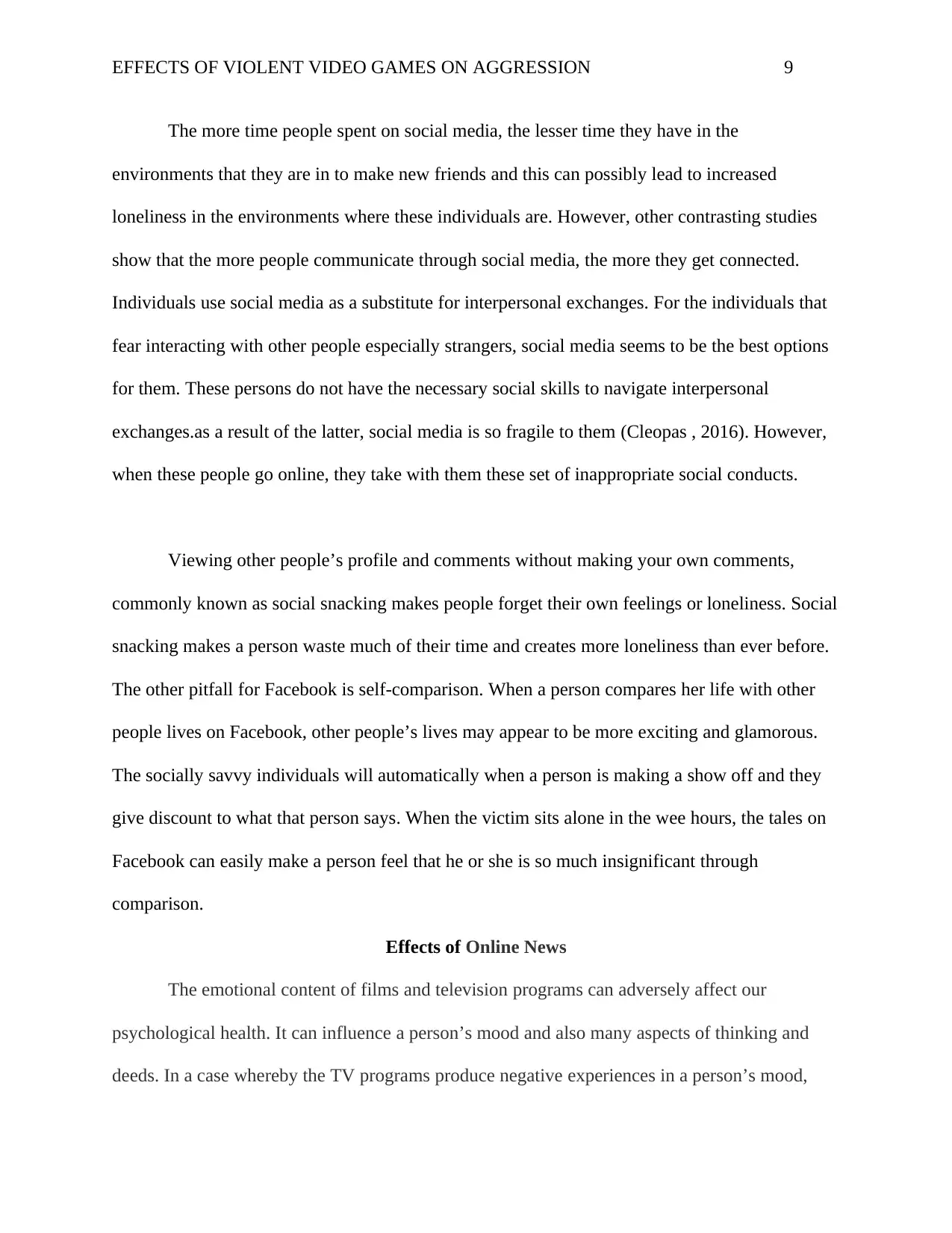
EFFECTS OF VIOLENT VIDEO GAMES ON AGGRESSION 9
The more time people spent on social media, the lesser time they have in the
environments that they are in to make new friends and this can possibly lead to increased
loneliness in the environments where these individuals are. However, other contrasting studies
show that the more people communicate through social media, the more they get connected.
Individuals use social media as a substitute for interpersonal exchanges. For the individuals that
fear interacting with other people especially strangers, social media seems to be the best options
for them. These persons do not have the necessary social skills to navigate interpersonal
exchanges.as a result of the latter, social media is so fragile to them (Cleopas , 2016). However,
when these people go online, they take with them these set of inappropriate social conducts.
Viewing other people’s profile and comments without making your own comments,
commonly known as social snacking makes people forget their own feelings or loneliness. Social
snacking makes a person waste much of their time and creates more loneliness than ever before.
The other pitfall for Facebook is self-comparison. When a person compares her life with other
people lives on Facebook, other people’s lives may appear to be more exciting and glamorous.
The socially savvy individuals will automatically when a person is making a show off and they
give discount to what that person says. When the victim sits alone in the wee hours, the tales on
Facebook can easily make a person feel that he or she is so much insignificant through
comparison.
Effects of Online News
The emotional content of films and television programs can adversely affect our
psychological health. It can influence a person’s mood and also many aspects of thinking and
deeds. In a case whereby the TV programs produce negative experiences in a person’s mood,
The more time people spent on social media, the lesser time they have in the
environments that they are in to make new friends and this can possibly lead to increased
loneliness in the environments where these individuals are. However, other contrasting studies
show that the more people communicate through social media, the more they get connected.
Individuals use social media as a substitute for interpersonal exchanges. For the individuals that
fear interacting with other people especially strangers, social media seems to be the best options
for them. These persons do not have the necessary social skills to navigate interpersonal
exchanges.as a result of the latter, social media is so fragile to them (Cleopas , 2016). However,
when these people go online, they take with them these set of inappropriate social conducts.
Viewing other people’s profile and comments without making your own comments,
commonly known as social snacking makes people forget their own feelings or loneliness. Social
snacking makes a person waste much of their time and creates more loneliness than ever before.
The other pitfall for Facebook is self-comparison. When a person compares her life with other
people lives on Facebook, other people’s lives may appear to be more exciting and glamorous.
The socially savvy individuals will automatically when a person is making a show off and they
give discount to what that person says. When the victim sits alone in the wee hours, the tales on
Facebook can easily make a person feel that he or she is so much insignificant through
comparison.
Effects of Online News
The emotional content of films and television programs can adversely affect our
psychological health. It can influence a person’s mood and also many aspects of thinking and
deeds. In a case whereby the TV programs produce negative experiences in a person’s mood,
⊘ This is a preview!⊘
Do you want full access?
Subscribe today to unlock all pages.

Trusted by 1+ million students worldwide
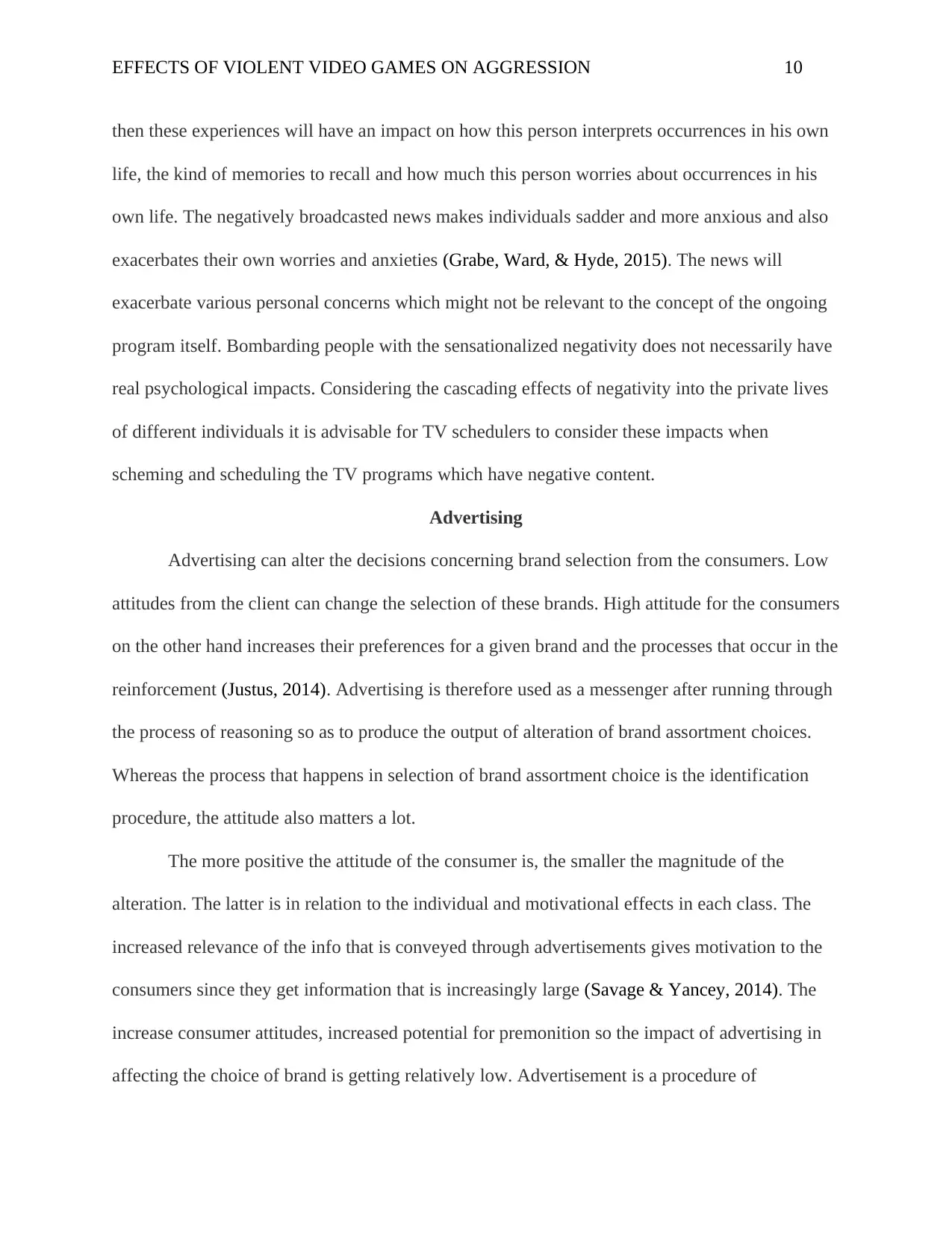
EFFECTS OF VIOLENT VIDEO GAMES ON AGGRESSION 10
then these experiences will have an impact on how this person interprets occurrences in his own
life, the kind of memories to recall and how much this person worries about occurrences in his
own life. The negatively broadcasted news makes individuals sadder and more anxious and also
exacerbates their own worries and anxieties (Grabe, Ward, & Hyde, 2015). The news will
exacerbate various personal concerns which might not be relevant to the concept of the ongoing
program itself. Bombarding people with the sensationalized negativity does not necessarily have
real psychological impacts. Considering the cascading effects of negativity into the private lives
of different individuals it is advisable for TV schedulers to consider these impacts when
scheming and scheduling the TV programs which have negative content.
Advertising
Advertising can alter the decisions concerning brand selection from the consumers. Low
attitudes from the client can change the selection of these brands. High attitude for the consumers
on the other hand increases their preferences for a given brand and the processes that occur in the
reinforcement (Justus, 2014). Advertising is therefore used as a messenger after running through
the process of reasoning so as to produce the output of alteration of brand assortment choices.
Whereas the process that happens in selection of brand assortment choice is the identification
procedure, the attitude also matters a lot.
The more positive the attitude of the consumer is, the smaller the magnitude of the
alteration. The latter is in relation to the individual and motivational effects in each class. The
increased relevance of the info that is conveyed through advertisements gives motivation to the
consumers since they get information that is increasingly large (Savage & Yancey, 2014). The
increase consumer attitudes, increased potential for premonition so the impact of advertising in
affecting the choice of brand is getting relatively low. Advertisement is a procedure of
then these experiences will have an impact on how this person interprets occurrences in his own
life, the kind of memories to recall and how much this person worries about occurrences in his
own life. The negatively broadcasted news makes individuals sadder and more anxious and also
exacerbates their own worries and anxieties (Grabe, Ward, & Hyde, 2015). The news will
exacerbate various personal concerns which might not be relevant to the concept of the ongoing
program itself. Bombarding people with the sensationalized negativity does not necessarily have
real psychological impacts. Considering the cascading effects of negativity into the private lives
of different individuals it is advisable for TV schedulers to consider these impacts when
scheming and scheduling the TV programs which have negative content.
Advertising
Advertising can alter the decisions concerning brand selection from the consumers. Low
attitudes from the client can change the selection of these brands. High attitude for the consumers
on the other hand increases their preferences for a given brand and the processes that occur in the
reinforcement (Justus, 2014). Advertising is therefore used as a messenger after running through
the process of reasoning so as to produce the output of alteration of brand assortment choices.
Whereas the process that happens in selection of brand assortment choice is the identification
procedure, the attitude also matters a lot.
The more positive the attitude of the consumer is, the smaller the magnitude of the
alteration. The latter is in relation to the individual and motivational effects in each class. The
increased relevance of the info that is conveyed through advertisements gives motivation to the
consumers since they get information that is increasingly large (Savage & Yancey, 2014). The
increase consumer attitudes, increased potential for premonition so the impact of advertising in
affecting the choice of brand is getting relatively low. Advertisement is a procedure of
Paraphrase This Document
Need a fresh take? Get an instant paraphrase of this document with our AI Paraphraser
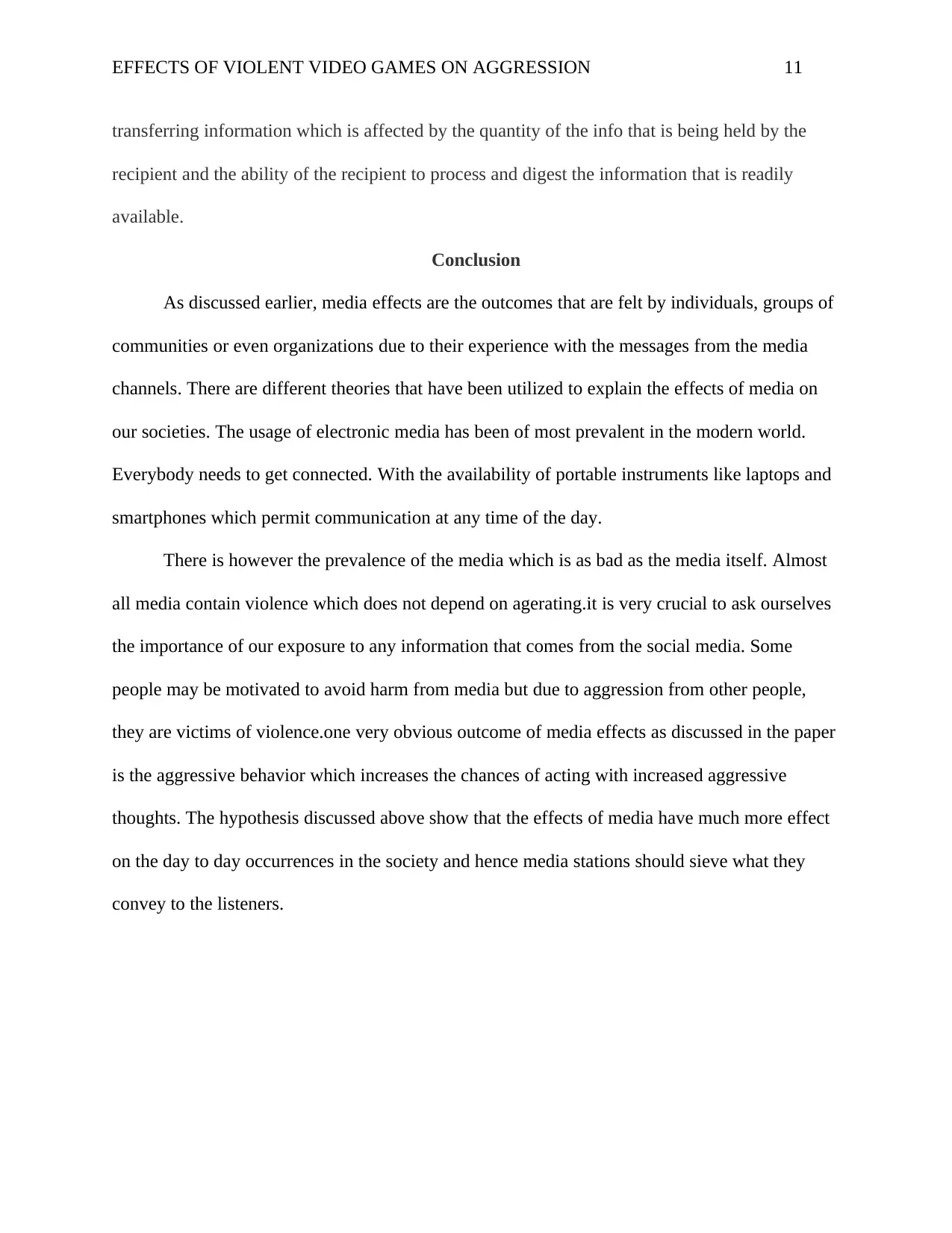
EFFECTS OF VIOLENT VIDEO GAMES ON AGGRESSION 11
transferring information which is affected by the quantity of the info that is being held by the
recipient and the ability of the recipient to process and digest the information that is readily
available.
Conclusion
As discussed earlier, media effects are the outcomes that are felt by individuals, groups of
communities or even organizations due to their experience with the messages from the media
channels. There are different theories that have been utilized to explain the effects of media on
our societies. The usage of electronic media has been of most prevalent in the modern world.
Everybody needs to get connected. With the availability of portable instruments like laptops and
smartphones which permit communication at any time of the day.
There is however the prevalence of the media which is as bad as the media itself. Almost
all media contain violence which does not depend on agerating.it is very crucial to ask ourselves
the importance of our exposure to any information that comes from the social media. Some
people may be motivated to avoid harm from media but due to aggression from other people,
they are victims of violence.one very obvious outcome of media effects as discussed in the paper
is the aggressive behavior which increases the chances of acting with increased aggressive
thoughts. The hypothesis discussed above show that the effects of media have much more effect
on the day to day occurrences in the society and hence media stations should sieve what they
convey to the listeners.
transferring information which is affected by the quantity of the info that is being held by the
recipient and the ability of the recipient to process and digest the information that is readily
available.
Conclusion
As discussed earlier, media effects are the outcomes that are felt by individuals, groups of
communities or even organizations due to their experience with the messages from the media
channels. There are different theories that have been utilized to explain the effects of media on
our societies. The usage of electronic media has been of most prevalent in the modern world.
Everybody needs to get connected. With the availability of portable instruments like laptops and
smartphones which permit communication at any time of the day.
There is however the prevalence of the media which is as bad as the media itself. Almost
all media contain violence which does not depend on agerating.it is very crucial to ask ourselves
the importance of our exposure to any information that comes from the social media. Some
people may be motivated to avoid harm from media but due to aggression from other people,
they are victims of violence.one very obvious outcome of media effects as discussed in the paper
is the aggressive behavior which increases the chances of acting with increased aggressive
thoughts. The hypothesis discussed above show that the effects of media have much more effect
on the day to day occurrences in the society and hence media stations should sieve what they
convey to the listeners.
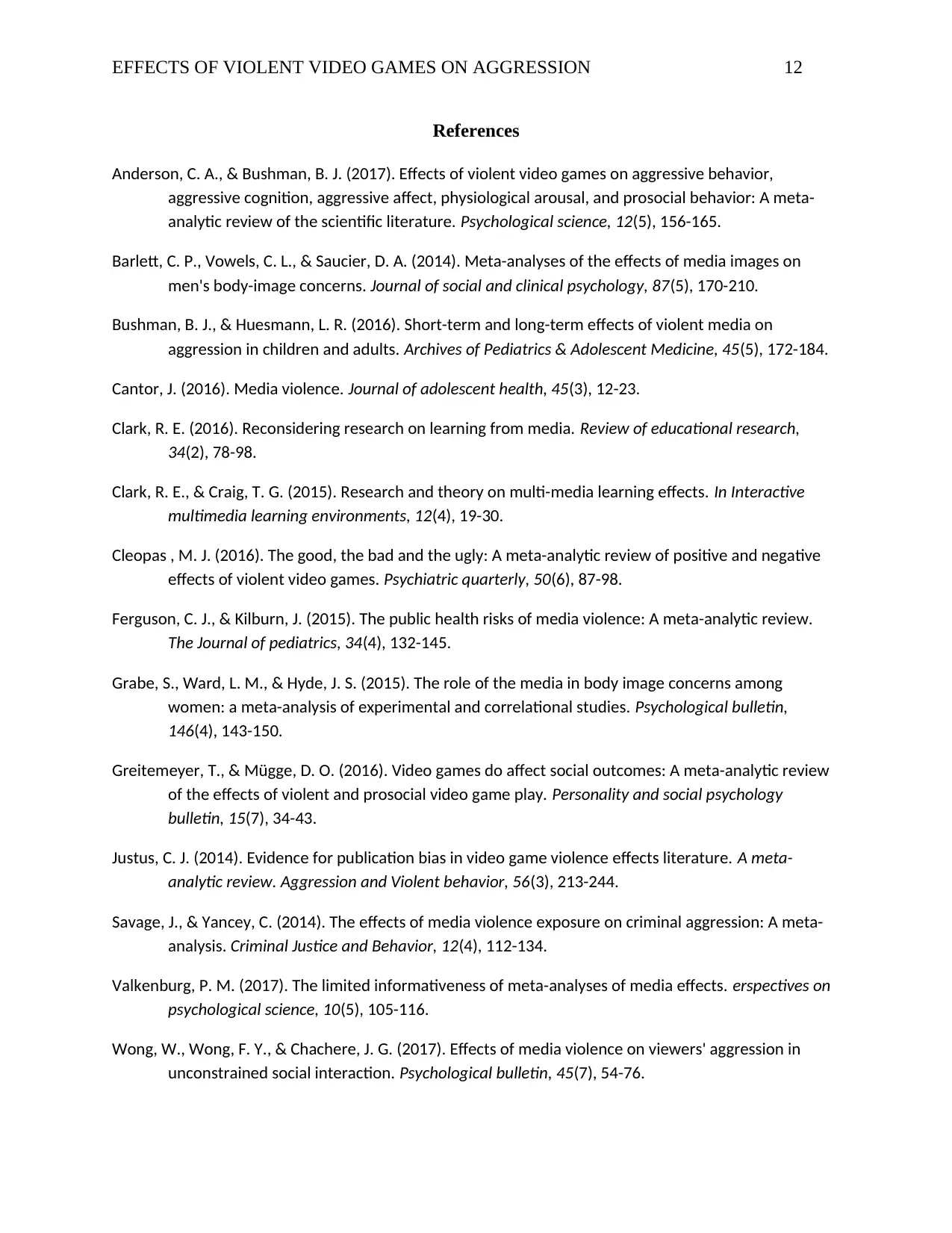
EFFECTS OF VIOLENT VIDEO GAMES ON AGGRESSION 12
References
Anderson, C. A., & Bushman, B. J. (2017). Effects of violent video games on aggressive behavior,
aggressive cognition, aggressive affect, physiological arousal, and prosocial behavior: A meta-
analytic review of the scientific literature. Psychological science, 12(5), 156-165.
Barlett, C. P., Vowels, C. L., & Saucier, D. A. (2014). Meta-analyses of the effects of media images on
men's body-image concerns. Journal of social and clinical psychology, 87(5), 170-210.
Bushman, B. J., & Huesmann, L. R. (2016). Short-term and long-term effects of violent media on
aggression in children and adults. Archives of Pediatrics & Adolescent Medicine, 45(5), 172-184.
Cantor, J. (2016). Media violence. Journal of adolescent health, 45(3), 12-23.
Clark, R. E. (2016). Reconsidering research on learning from media. Review of educational research,
34(2), 78-98.
Clark, R. E., & Craig, T. G. (2015). Research and theory on multi-media learning effects. In Interactive
multimedia learning environments, 12(4), 19-30.
Cleopas , M. J. (2016). The good, the bad and the ugly: A meta-analytic review of positive and negative
effects of violent video games. Psychiatric quarterly, 50(6), 87-98.
Ferguson, C. J., & Kilburn, J. (2015). The public health risks of media violence: A meta-analytic review.
The Journal of pediatrics, 34(4), 132-145.
Grabe, S., Ward, L. M., & Hyde, J. S. (2015). The role of the media in body image concerns among
women: a meta-analysis of experimental and correlational studies. Psychological bulletin,
146(4), 143-150.
Greitemeyer, T., & Mügge, D. O. (2016). Video games do affect social outcomes: A meta-analytic review
of the effects of violent and prosocial video game play. Personality and social psychology
bulletin, 15(7), 34-43.
Justus, C. J. (2014). Evidence for publication bias in video game violence effects literature. A meta-
analytic review. Aggression and Violent behavior, 56(3), 213-244.
Savage, J., & Yancey, C. (2014). The effects of media violence exposure on criminal aggression: A meta-
analysis. Criminal Justice and Behavior, 12(4), 112-134.
Valkenburg, P. M. (2017). The limited informativeness of meta-analyses of media effects. erspectives on
psychological science, 10(5), 105-116.
Wong, W., Wong, F. Y., & Chachere, J. G. (2017). Effects of media violence on viewers' aggression in
unconstrained social interaction. Psychological bulletin, 45(7), 54-76.
References
Anderson, C. A., & Bushman, B. J. (2017). Effects of violent video games on aggressive behavior,
aggressive cognition, aggressive affect, physiological arousal, and prosocial behavior: A meta-
analytic review of the scientific literature. Psychological science, 12(5), 156-165.
Barlett, C. P., Vowels, C. L., & Saucier, D. A. (2014). Meta-analyses of the effects of media images on
men's body-image concerns. Journal of social and clinical psychology, 87(5), 170-210.
Bushman, B. J., & Huesmann, L. R. (2016). Short-term and long-term effects of violent media on
aggression in children and adults. Archives of Pediatrics & Adolescent Medicine, 45(5), 172-184.
Cantor, J. (2016). Media violence. Journal of adolescent health, 45(3), 12-23.
Clark, R. E. (2016). Reconsidering research on learning from media. Review of educational research,
34(2), 78-98.
Clark, R. E., & Craig, T. G. (2015). Research and theory on multi-media learning effects. In Interactive
multimedia learning environments, 12(4), 19-30.
Cleopas , M. J. (2016). The good, the bad and the ugly: A meta-analytic review of positive and negative
effects of violent video games. Psychiatric quarterly, 50(6), 87-98.
Ferguson, C. J., & Kilburn, J. (2015). The public health risks of media violence: A meta-analytic review.
The Journal of pediatrics, 34(4), 132-145.
Grabe, S., Ward, L. M., & Hyde, J. S. (2015). The role of the media in body image concerns among
women: a meta-analysis of experimental and correlational studies. Psychological bulletin,
146(4), 143-150.
Greitemeyer, T., & Mügge, D. O. (2016). Video games do affect social outcomes: A meta-analytic review
of the effects of violent and prosocial video game play. Personality and social psychology
bulletin, 15(7), 34-43.
Justus, C. J. (2014). Evidence for publication bias in video game violence effects literature. A meta-
analytic review. Aggression and Violent behavior, 56(3), 213-244.
Savage, J., & Yancey, C. (2014). The effects of media violence exposure on criminal aggression: A meta-
analysis. Criminal Justice and Behavior, 12(4), 112-134.
Valkenburg, P. M. (2017). The limited informativeness of meta-analyses of media effects. erspectives on
psychological science, 10(5), 105-116.
Wong, W., Wong, F. Y., & Chachere, J. G. (2017). Effects of media violence on viewers' aggression in
unconstrained social interaction. Psychological bulletin, 45(7), 54-76.
⊘ This is a preview!⊘
Do you want full access?
Subscribe today to unlock all pages.

Trusted by 1+ million students worldwide
1 out of 13
Your All-in-One AI-Powered Toolkit for Academic Success.
+13062052269
info@desklib.com
Available 24*7 on WhatsApp / Email
![[object Object]](/_next/static/media/star-bottom.7253800d.svg)
Unlock your academic potential
Copyright © 2020–2025 A2Z Services. All Rights Reserved. Developed and managed by ZUCOL.


